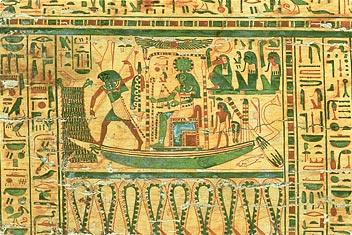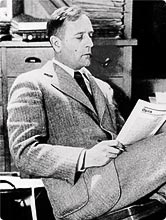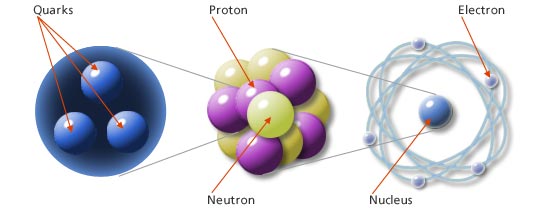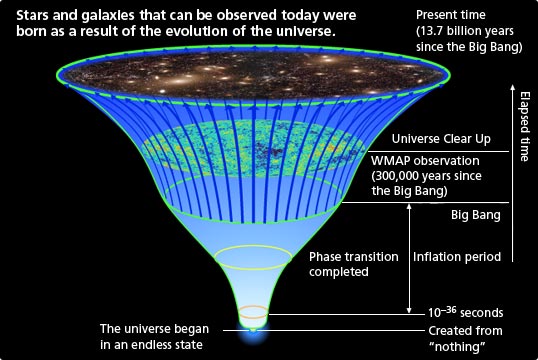When was the oldest light in the universe born? And how? Light's memory offers us a fascinating glimpse of the universe.
“In the beginning, there was light.”

Sun god Ra traveling through the waters of heaven in a boat
© Fitzwilliam Museum, University of Cambridge, UK / The Bridgeman Art Library / PPS
The sun's light is necessary for all life on Earth. The ancients saw light as sacred, and in many cultures the sun was thought of as a god. In ancient Egypt, the sun god Ra was envisioned as traveling through the heavens on a great boat—when he flew through the sky it was day, and when he traveled through the underworld it became night.
In the Bible, God created the world with the words “Let there be light.” How did the universe begin, and how did the first light appear from darkness? Humans have asked these questions for thousands of years, but only now is science beginning to provide answers. Here, we discuss “the first and oldest light in the universe.”
What the light from the galaxies says
Sunlight, lamplight, and even the oldest light in the universe are all considered to be “light.” But what exactly is light?
Light has characteristics of both particles (photons) and waves. The distance between wave peaks is called “wavelength.” Even though we refer to different ranges of the electromagnetic spectrum differently according to wavelength, it is actually all one continuum of electromagnetic radiation that includes everything from visible to ultraviolet light to X rays and beyond.
An interesting phenomenon occurs when a source of light moves. If a light source moves away from an observer, the wavelength extends. In case of visible light, the light shifts toward the red in the spectrum. This is known as the “red shift.”
An observer (right) will see that galaxies moving away emit light that extends. This light appears to shift toward the red in the spectrum. This is known as a red shift or the Doppler effect on light.

Edwin Hubble. Discovered the universe was expanding by observing light from galaxies.
©SCIENCE PHOTO LIBRARY / PPS
It was Edwin Hubble who first noticed galactic red shift. A man of many talents, Hubble was a heavy-weight boxer at school and then a lawyer before becoming an astronomer, and noticing for the first time the mysterious phenomenon that light from other galaxies showed red shifts. This means that all galaxies are moving away from Earth.
Hubble also noticed that the further away the galaxies are, the faster they are moving away, meaning that the universe is expanding. This discovery was made in 1929.
Proof of a hot universe
The universe is expanding even at this moment, and eons ago it must have been very small. In 1948, an American physicist, George Gamow, proposed the Big Bang theory that the universe originated from a single particle. This theory was met with extreme skepticism—until proof was discovered.
Everything radiates electromagnetic radiation (light), even our bodies. The wavelength of radiation or light depends on the temperature of the object.
If the entire universe was once condensed in a single particle, then the intense compression of all substances and energy would result in intense heat, which would have emitted radiation of a corresponding wavelength. The apparent temperature of this light would have cooled down as the universe expanded after the Big Bang. In other words, astronomers expected to find light somewhere in the universe to prove that it was once hot.
As it happened, this electromagnetic radiation was first observed by chance in 1965 by two researchers, Arno Penzias and Robert Woodrow Wilson, at Bell Laboratories in the United States.
At first they thought this radiation, which was everywhere, was merely “noise.” However, the noise itself was the very light emitted when the universe was still hot. Although once hot, this radiation had cooled to an apparent temperature of 3 K (Kelvin: international unit of heat, 3 K = -270°C) since the time it first appeared along with the expansion of the universe.
Known as 3 Degree Kelvin Background Radiation*1, or Cosmic Microwave Background (CMB) Radiation, this is indeed the oldest light in the universe.
- *13 Degree Kelvin Background Radiation
Also called Cosmic Microwave Background Radiation. Some 300 thousand years after the Big Bang, electrons that had inhibited light to travel in a straight line were captured by atoms, allowing radiation to travel straight. The radiation then emitted cooled down to the temperature of 3K with the expansion of the universe, becoming observable for the first time. This observable radiation is known as 3 Degree Kelvin Background Radiation.
What the oldest light in the universe teaches us
The latest cosmological theory tells us that the universe was born from “nothing,” a state of “placelessness and timelessness,” and then inflated rapidly for a short period of time. This is the theory of inflation first proposed by Professor Katsuhiko Sato of University of Tokyo.
After inflation, the universe took on the state of a fireball, called the “Big Bang.” During this time, elementary particles collided so violently with each other that these particles prevented electromagnetic radiation from traveling in a straight line.
As the universe expanded and cooled, elementary particles coalesced and formed substances. When atoms were finally formed, electromagnetic radiation (light) which was blocked could finally travel straight, through space. It was at this moment, about 300,000 years after the Big Bang, that CMB radiation was born. This is the oldest light in the universe, emitted in the instant physicists call “Universe Clear Up.”

Fundamental particle quarks gather to form neutrons and protons, which form atomic nuclei. Electrons were captured by nuclei to form atoms.

The theory of the inflating universe was first proposed by Professor Katsuhiko Sato of University of Tokyo. It was once thought that the universe began from a singular point (where physics is ineffective). But this does not theoretically explain the origin of the universe. Professor Sato and others explained that the universe was born from “nothing” or a state of “placelessness and timelessness,” and experienced rapid inflation, and then developed into a fireball known as the “Big Bang.” After 300,000 years, the oldest light in the universe, CMB radiation, was released.
In 2003, NASA and other groups launched a satellite under the WMAP*2 (Wilkinson Microwave Anisotropy Probe) project to accurately measure cosmic microwave background radiation.
By comparing the observed data with model-based calculations, we can learn many things from the universe's oldest light. First, the age of the universe is about 13.7 billion years. Also, the substances that we can see around us make up only about 4% of the total matter and energy in the universe, 96% of which is unknown or “dark” to us.

Temperature distribution of CMB radiation. There is only a 1/100,000 of a degree difference between the red and blue portions of the map.
©NASA
Seventy-three percent of the remaining portion of the universe is thought to be dark energy, 23% of which is dark matter. No one has yet discovered what this is, but researchers around the world are racing to identify it (see “Invisible mass”—Dark matter and The dark energy that permeates the universe.). It is hoped that this mystery can be solved with the use of world-class telescopes (such as Subaru in Hawaii) and their observational instruments.
The oldest light in the universe enables us to make the newest discoveries about the universe.

WMAP observations reveal the composition of the universe. Energy and matter we can see breaks down to only 4% of the universe, while 23% of which is dark matter and 73% of which dark energy, the nature of which is not yet known.
©NASA
- *2WMAP
A NASA program to accurately measure CMB radiation. In 2001 a satellite was launched, and in 2003 detailed radiation measurements were released.
Editorial contributor / Date of article posted
Professor Katsuhiko Sato of University of Tokyo / August 2005

